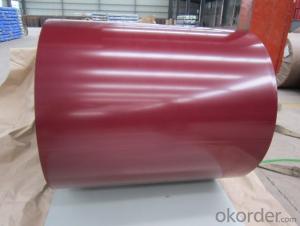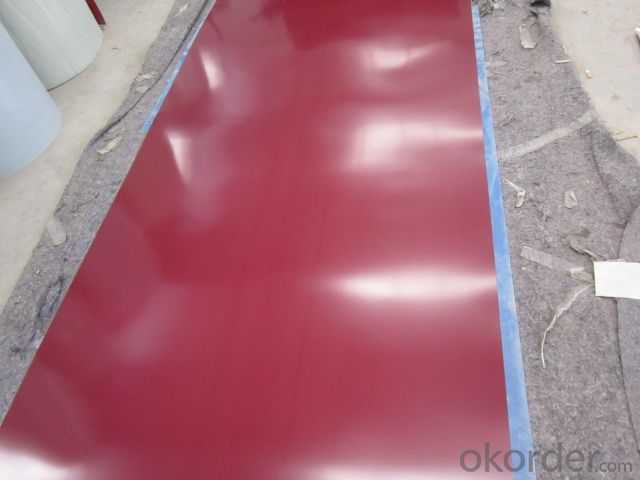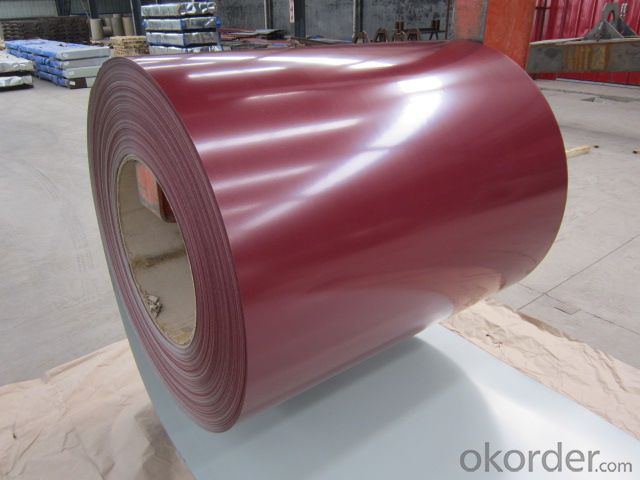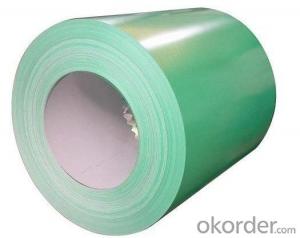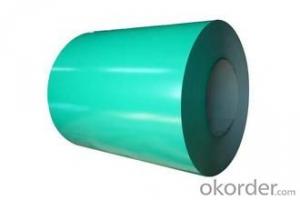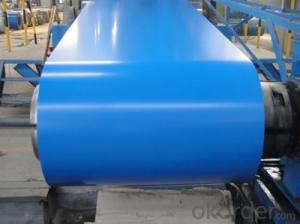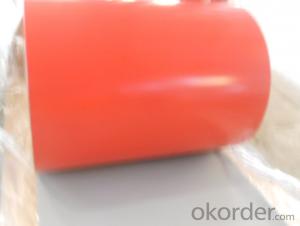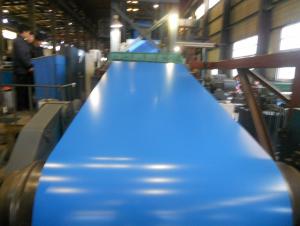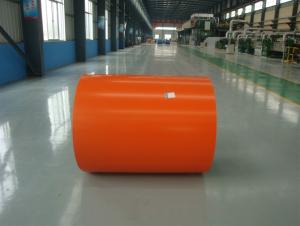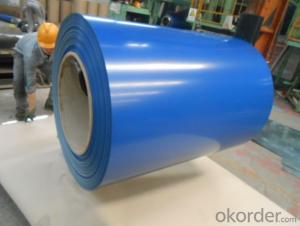Pre Painted Galvanised Steel Coil in coil
- Loading Port:
- Shanghai
- Payment Terms:
- TT OR LC
- Min Order Qty:
- 25 m.t.
- Supply Capability:
- 10000 m.t./month
OKorder Service Pledge
OKorder Financial Service
You Might Also Like
Pre Painted Galvanised Steel Coil
Description:
The production process has evolved from one-coating-and-one-baking to double-coating-and-double-baking, and even three-coating-and-three-baking.
The base metals for Pre Painted Steel Coil consist of cold rolled, HDG electro-galvanized and hot-dip alu-zinc coated steel. The finish coats of Pre Painted Steel Coil can be classified into groups as follows: polyester, silicon modified polyesters, polyvinylidene fluoride, high-durability polyester, etc.
The Pre Painted Steel Coil can also be classified into groups by their surface textures, namely regular prepainted sheets, embossed sheets and printed sheets.
Application:
Suitable for indoor or outdoor decoration, color lasting for at least 10 years for outdoor using, could for roll forming., conditioning, micro-wave oven, bread maker,solar water heater,condencing apparatus,Blackboard, white board,chalkboard, hidden cell blackboard,bulletin board,Central heating slice, lampshade, chifforobe, desk, bed, locker, bookshelf,garbage can, billboard, typewriter, instrument panel, weight sensor, photographic equipment,coffin, fence, Prepainted Galvanized Steel Coil
Product Specification:
Paint: PE or PVDF
Color pre painted steel in coil
Thickness: 0.3-0.8mm
Width: 914-1250mm
Inner Diameter: 508mm,610MM
Weight of Steel Coil: 3-8MT
Available Dipped Layer: 50-150g/m2
Coating Type: Al-Zn Alloy
Front Side Paint Thickness: 15-25μm
Back Side Paint Thickness: 5-10μm
STANDARD:JIS G3312,CGCC
FAQ:
1.How about the color of the Pre Painted Steel Coil
The color of the Pre Painted Steel Coil has a very wide selection, like orange, cream-colored, dark sky blue, sea blue, bright red, brick red, ivory white, porcelain blue.
2.Could you tell me the package for the Pre Painted Steel Coil?
Usually Standard export seaworthy package: waterproof paper+steel trip packed+wooden case seaworthy package
3. Can you produce the goods according to the customer’s requirements?
Yes, of course, it can be customized according to customers requirements.
- Q: What are the common coil loading and unloading procedures?
- The common coil loading and unloading procedures typically involve the use of specialized equipment such as cranes or forklifts to safely lift and transport the coils. The procedure may vary depending on factors such as the size and weight of the coils, as well as the specific requirements of the industry. Generally, the coils are loaded or unloaded by carefully positioning them onto or off of a designated storage area or transportation vehicle. The process often includes securing the coils with straps or clamps to prevent any movement or damage during transportation. Proper handling and adherence to safety protocols are crucial to ensure the successful loading and unloading of coils.
- Q: What are the safety precautions when working with steel coils?
- When working with steel coils, it is important to follow several safety precautions. Firstly, workers should wear appropriate personal protective equipment (PPE) such as gloves, safety glasses, and steel-toe boots to protect themselves from potential injuries. Additionally, they should ensure that the work area is well-lit and free from any trip hazards. Proper lifting techniques should be used to prevent strains or sprains, and workers should be trained on how to safely operate any machinery or equipment involved in handling the coils. Regular inspections of the coils, checking for any defects or damages, should also be conducted to avoid accidents. Lastly, workers should be aware of the potential hazards associated with working with steel coils, such as sharp edges, pinching points, and the risk of heavy objects falling, and take necessary precautions to minimize these risks.
- Q: What are the industries that consume the most steel?
- I'm guessing manufacturing
- Q: What is the purpose of steel coils?
- The purpose of steel coils is to efficiently store and transport large quantities of steel in a compact and organized manner.
- Q: How are steel coils used in the production of marine vessels?
- Steel coils are used in the production of marine vessels primarily for their strength, durability, and corrosion resistance. These coils are shaped and formed into various components such as hulls, decks, and bulkheads, providing a sturdy framework for the entire vessel. By utilizing steel coils, marine vessels gain the necessary structural integrity to withstand harsh marine environments and ensure the safety and reliability of the vessels.
- Q: How are steel coils used in the manufacturing of oil and gas equipment?
- Steel coils are used in the manufacturing of oil and gas equipment as they provide strength and durability to withstand harsh conditions. These coils are often shaped and welded to create various components such as pipes, tanks, and pressure vessels. Additionally, steel coils are also used in the fabrication of structural frames and supports for oil and gas equipment, ensuring stability and reliability in the industry.
- Q: Can steel coils be coated with anti-slip materials?
- Yes, steel coils can be coated with anti-slip materials. These materials can provide additional friction and grip to prevent slipping and sliding during transportation or handling.
- Q: What are the common methods of slitting or shearing steel coils?
- The common methods of slitting or shearing steel coils include: 1. Rotary Shearing: This method involves using a rotary shear machine that uses a set of rotating blades to cut through the steel coil. The blades move in a circular motion, slicing through the coil to create individual strips of the desired width. 2. Scissor Shearing: Scissor shearing is another common method of cutting steel coils. It involves using a pair of scissor-like blades to make the cuts. The blades are typically operated by hydraulic or mechanical systems, and they cut through the coil by exerting pressure on the material. 3. Slitting: Slitting is a popular method used to cut steel coils into narrower strips. It involves passing the coil through a set of circular blades, known as slitters, which are set at specific distances apart. The slitters cut through the coil, creating multiple narrower strips of the desired width. 4. Guillotine Shearing: Guillotine shearing is a method that uses a large, powerful guillotine machine to cut through the steel coil. The machine features a long blade that moves vertically to shear the coil. This method is often used for thicker steel coils and can produce clean, straight cuts. 5. Laser Cutting: Laser cutting is a more advanced method that uses a high-powered laser beam to cut through steel coils. The laser beam is directed by computer-controlled systems, allowing for precise and accurate cutting. Laser cutting is often used for complex shapes or when high precision is required. Each of these methods has its advantages and is suitable for different applications. Factors such as the thickness of the steel coil, desired strip width, and the level of precision required will determine the most appropriate method to use.
- Q: What are the different methods of edge camber correction for steel coils?
- There are several methods used for edge camber correction in steel coils, depending on the specific requirements and equipment available. Some of the common methods include: 1. Mechanical Edge Trimming: This method involves trimming the edges of the coil using mechanical tools such as shears or slitters. It helps to remove excess material and correct the camber. This method is often used for smaller coils or when the camber is minimal. 2. Tension Leveling: Tension leveling is a process where the coil is passed through a series of adjustable rollers under tension. The tension helps to elongate the steel and reduce the camber. This method is effective for correcting moderate camber and is commonly used for larger coils. 3. Roller Leveling: Roller leveling is similar to tension leveling, but instead of adjustable rollers, the coil is passed through a series of fixed rollers. These rollers exert pressure on the steel to flatten it and correct the edge camber. This method is often used for thicker and heavier coils. 4. Heat Straightening: Heat straightening involves applying controlled heat to the edges of the coil to soften the steel. Once the steel becomes malleable, external force is applied to straighten the edges. This method is suitable for correcting severe edge camber but requires specialized equipment and expertise. 5. Combination Methods: In some cases, a combination of different methods may be used to achieve the desired edge camber correction. For example, mechanical edge trimming may be followed by tension leveling or roller leveling to further straighten the edges. It is worth mentioning that the choice of method depends on various factors such as the severity of camber, coil dimensions, material properties, and available equipment. It is essential to evaluate these factors and consult with experts to determine the most suitable method for edge camber correction in steel coils.
- Q: How are steel coils inspected for flatness using optical sensors?
- Steel coils are inspected for flatness using optical sensors by measuring the surface profile of the coil. These sensors use laser or camera technology to scan the coil's surface and detect any deviations from a perfectly flat shape. The collected data is then analyzed to identify any areas that do not meet the required flatness criteria, allowing for necessary adjustments to be made before the steel coils are further processed or shipped.
Send your message to us
Pre Painted Galvanised Steel Coil in coil
- Loading Port:
- Shanghai
- Payment Terms:
- TT OR LC
- Min Order Qty:
- 25 m.t.
- Supply Capability:
- 10000 m.t./month
OKorder Service Pledge
OKorder Financial Service
Similar products
Hot products
Hot Searches
Related keywords
